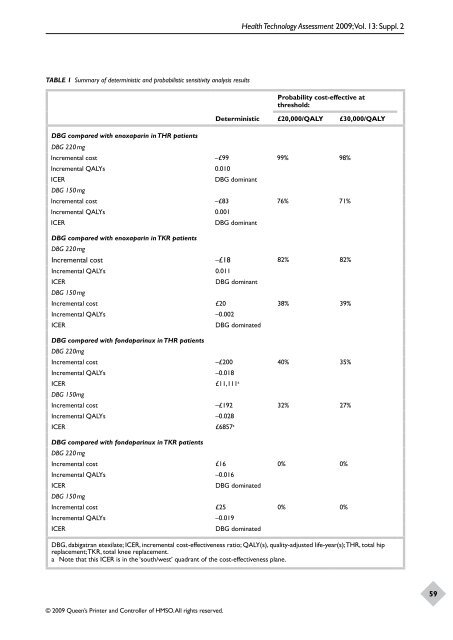Dabigatran etexilate for the prevention of venous thromboembolism ...
Dabigatran etexilate for the prevention of venous thromboembolism ... Dabigatran etexilate for the prevention of venous thromboembolism ...
Dabigatran etexilate for the prevention of venous thromboembolism58once daily dose in the special populations indicatedfor this lower dose and for whom the lower doseis specifically licensed. Safety outcomes were notreported for these subgroups.The meta-analysis of the RE-MODEL and RE-NOVATE trials appears to show that the 150-mgonce daily dose of DBG is not inferior to thecomparator enoxaparin (at either 40 mg once dailyor 30 mg twice daily) in reducing levels of total VTEand all-cause mortality among patients undergoingtotal hip replacement and total knee replacement.The meta-analyses of the two total kneereplacement trials combined (RE-MODEL and RE-MOBILIZE) and the three total knee replacementand total hip replacement trials combined (RE-NOVATE, RE-MODEL and RE-MOBILIZE) appearto show that the 150-mg once daily dose of DBGis inferior to the comparator enoxaparin (at both40 mg once daily and 30 mg twice daily) in reducinglevels of total VTE and all-cause mortality amongpatients undergoing total hip replacement andtotal knee replacement.An MTC analysis compared the results of thesetrials of DBG with results for all other availableinterventions for patients undergoing surgery andat risk of DVT and found that DBG comparedfavourably with the other interventions, withthe exception of extended enoxaparin andfondaparinux, which appear to be relativelymore effective (level of statistical significance ofdifference not reported).The adverse event profile was not significantlydifferent in those receiving DBG compared withthose receiving enoxaparin. The primary safetyend point was major bleeding. Clinically relevantbleeding, any bleeding and liver function were alsomeasured (secondary end points).Summary of submitted costeffectivenessevidenceThe model developed by Boehringer Ingelheimhas an acute phase that starts at the time of surgeryand ends at 10 weeks post surgery and a chronicphase with a lifetime horizon. The model comparesDBG with enoxaparin and fondaparinux in bothtotal hip replacement and total knee replacement.The acute phase model is a decision tree whichpredicts the health states that patients will be in at10 weeks based on evidence from phase III trials ofDBG compared with enoxaparin and from an MTCof DBG compared with fondaparinux. At 10 weekspatients enter a chronic phase Markov model inthe same health state in which they terminated thedecision tree model. No further treatment effectis applied in the chronic phase model. Transitionbetween states in the chronic phase model isdependent on VTE recurrence rates obtained fromthe literature.The health states, costs, utilities and recurrencerates used within the model are considered to beappropriate for the required analysis.The Boehringer Ingelheim model estimated that:• at the licensed dose of 220 mg once dailyDBG dominates enoxaparin in both total hipreplacement and total knee replacement• at the lower dose of 150 mg once daily DBGdominates enoxaparin in total hip replacementand enoxaparin dominates DBG in total kneereplacement• DBG is less cost-effective than fondaparinuxin total hip replacement at both doses of DBG.The cost/QALY of fondaparinux versus DBG is£11,111 and £6857, respectively, for the higherand lower doses of DBG.• In total knee replacement, both DBG doses aredominated by fondaparinux.Table 1 presents a summary of the cost-effectivenessresults. For DBG versus all comparators it shouldbe noted that in all cases the cost-effectivenessresults are based on small incremental cost andhealth benefits.Commentary onthe robustness ofsubmitted evidenceStrengthsThe manufacturer conducted a limited, butsystematic search for clinical and cost-effectivenessstudies of DBG for the prevention of VTE inpatients undergoing total knee replacement andtotal hip replacement. It appears unlikely thatany additional trials would have met the inclusioncriteria had the search been widened to includemore free-text terms or to include other databases.The three identified trials, which represent themain clinical efficacy evidence, were of reasonablemethodological quality, with some limitations,and measured a range of outcomes that wereappropriate and clinically relevant.
Health Technology Assessment 2009; Vol. 13: Suppl. 2TABLE 1 Summary of deterministic and probabilistic sensitivity analysis resultsProbability cost-effective atthreshold:Deterministic £20,000/QALY £30,000/QALYDBG compared with enoxaparin in THR patientsDBG 220 mgIncremental cost –£99 99% 98%Incremental QALYs 0.010ICERDBG dominantDBG 150 mgIncremental cost –£83 76% 71%Incremental QALYs 0.001ICERDBG dominantDBG compared with enoxaparin in TKR patientsDBG 220 mgIncremental cost –£18 82% 82%Incremental QALYs 0.011ICERDBG dominantDBG 150 mgIncremental cost £20 38% 39%Incremental QALYs –0.002ICERDBG dominatedDBG compared with fondaparinux in THR patientsDBG 220mgIncremental cost –£200 40% 35%Incremental QALYs –0.018ICER£11,111 aDBG 150mgIncremental cost –£192 32% 27%Incremental QALYs –0.028ICER£6857 aDBG compared with fondaparinux in TKR patientsDBG 220 mgIncremental cost £16 0% 0%Incremental QALYs –0.016ICERDBG dominatedDBG 150 mgIncremental cost £25 0% 0%Incremental QALYs –0.019ICERDBG dominatedDBG, dabigatran etexilate; ICER, incremental cost-effectiveness ratio; QALY(s), quality-adjusted life-year(s); THR, total hipreplacement; TKR, total knee replacement.a Note that this ICER is in the ‘south/west’ quadrant of the cost-effectiveness plane.59© 2009 Queen’s Printer and Controller of HMSO. All rights reserved.
- Page 1 and 2: DOI: 10.3310/hta13suppl2/08Health T
- Page 6 and 7: Dabigatran etexilate for the preven
- Page 8: Dabigatran etexilate for the preven
Health Technology Assessment 2009; Vol. 13: Suppl. 2TABLE 1 Summary <strong>of</strong> deterministic and probabilistic sensitivity analysis resultsProbability cost-effective atthreshold:Deterministic £20,000/QALY £30,000/QALYDBG compared with enoxaparin in THR patientsDBG 220 mgIncremental cost –£99 99% 98%Incremental QALYs 0.010ICERDBG dominantDBG 150 mgIncremental cost –£83 76% 71%Incremental QALYs 0.001ICERDBG dominantDBG compared with enoxaparin in TKR patientsDBG 220 mgIncremental cost –£18 82% 82%Incremental QALYs 0.011ICERDBG dominantDBG 150 mgIncremental cost £20 38% 39%Incremental QALYs –0.002ICERDBG dominatedDBG compared with fondaparinux in THR patientsDBG 220mgIncremental cost –£200 40% 35%Incremental QALYs –0.018ICER£11,111 aDBG 150mgIncremental cost –£192 32% 27%Incremental QALYs –0.028ICER£6857 aDBG compared with fondaparinux in TKR patientsDBG 220 mgIncremental cost £16 0% 0%Incremental QALYs –0.016ICERDBG dominatedDBG 150 mgIncremental cost £25 0% 0%Incremental QALYs –0.019ICERDBG dominatedDBG, dabigatran <strong>etexilate</strong>; ICER, incremental cost-effectiveness ratio; QALY(s), quality-adjusted life-year(s); THR, total hipreplacement; TKR, total knee replacement.a Note that this ICER is in <strong>the</strong> ‘south/west’ quadrant <strong>of</strong> <strong>the</strong> cost-effectiveness plane.59© 2009 Queen’s Printer and Controller <strong>of</strong> HMSO. All rights reserved.



